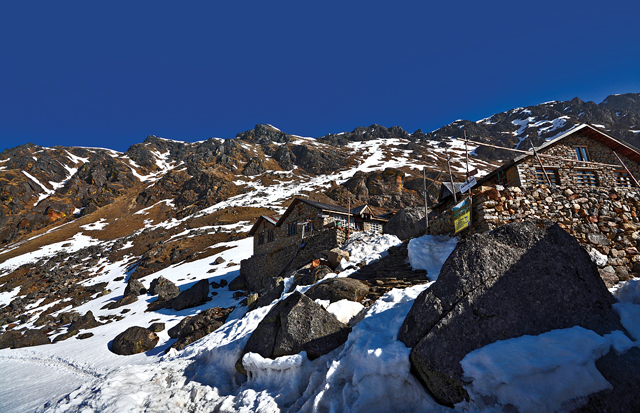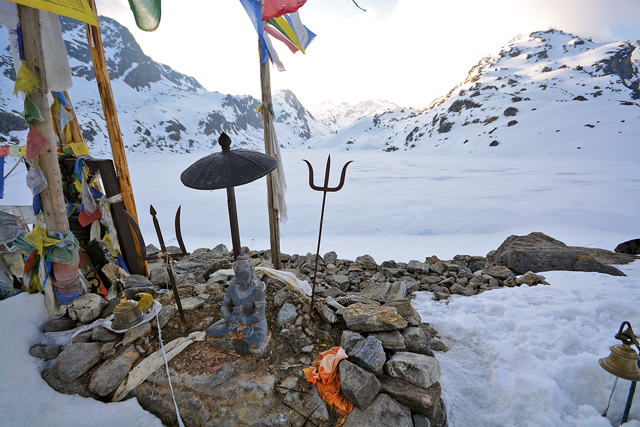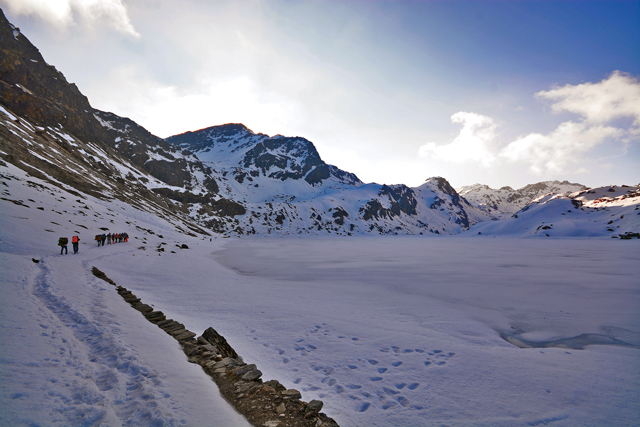It’s a journey that supposedly cleanses you of all past sins, and gives you a fresh start to life. Who doesn’t want that?
 Situated at an altitude of 4,380 m in Rasuwa district is the famous glacier lake, Gosainkunda. According to Hindu mythology, in the beginning of time, the gods churned the primordial oceans to produce the elixir of eternal life. A vile poison was also produced in the process. The gods went to Lord Shiva, seeking help. He decided that he would drink the poison to destroy it. The poison was so strong that it turned his throat into a bluish hue (origin of the term “Neel Kantha” for Shiva). The lake is believed to have come to existence when Lord Shiva thrust his trishul (trident) into a mountain to extract water to soothe his throat, and bring harmony to the universe. People still claim that they see Lord Shiva’s reflection in the waters. A large rock is visible towards the center of the lake. It is said to be the remains of an ancient Shiva shrine. The lake has a very important significance in Hindu religion. Hordes of devotees gather at the lake on the full moon night of August to bathe in its waters. It is believed that people who do so are cleansed of every sin that they have committed, and are granted a clean slate in life.
Situated at an altitude of 4,380 m in Rasuwa district is the famous glacier lake, Gosainkunda. According to Hindu mythology, in the beginning of time, the gods churned the primordial oceans to produce the elixir of eternal life. A vile poison was also produced in the process. The gods went to Lord Shiva, seeking help. He decided that he would drink the poison to destroy it. The poison was so strong that it turned his throat into a bluish hue (origin of the term “Neel Kantha” for Shiva). The lake is believed to have come to existence when Lord Shiva thrust his trishul (trident) into a mountain to extract water to soothe his throat, and bring harmony to the universe. People still claim that they see Lord Shiva’s reflection in the waters. A large rock is visible towards the center of the lake. It is said to be the remains of an ancient Shiva shrine. The lake has a very important significance in Hindu religion. Hordes of devotees gather at the lake on the full moon night of August to bathe in its waters. It is believed that people who do so are cleansed of every sin that they have committed, and are granted a clean slate in life.
 Gosainkunda is located towards the north of Kathmandu, and will generally take three days to reach. A bus ride from Balaju will first take you to Dhunche (117 km). We were a group of seven, and our reserved micro-bus took us seven hours to reach our destination. We came to understand that we could have reached Dhunche faster had we booked a fairly more expensive TATA jeep as our transport. The basic fare ranges from Rs. 600 to Rs. 1,000, depending on the type of vehicle you pick. Though the journey was smooth in the beginning, we did come across quite a few heavily damaged roads that were just calling for disaster to happen. Fortunately, we encountered none. Once at Dhunche, you can either choose to spend the night there, or walk four-five hours to Deurali (2,625 m). Dhunche has a lot of hotels, lodges, and restaurants, and many decide on spending the first night here. Since we reached early, and had a few hours of daylight to spare, we chose the latter option.
Gosainkunda is located towards the north of Kathmandu, and will generally take three days to reach. A bus ride from Balaju will first take you to Dhunche (117 km). We were a group of seven, and our reserved micro-bus took us seven hours to reach our destination. We came to understand that we could have reached Dhunche faster had we booked a fairly more expensive TATA jeep as our transport. The basic fare ranges from Rs. 600 to Rs. 1,000, depending on the type of vehicle you pick. Though the journey was smooth in the beginning, we did come across quite a few heavily damaged roads that were just calling for disaster to happen. Fortunately, we encountered none. Once at Dhunche, you can either choose to spend the night there, or walk four-five hours to Deurali (2,625 m). Dhunche has a lot of hotels, lodges, and restaurants, and many decide on spending the first night here. Since we reached early, and had a few hours of daylight to spare, we chose the latter option.

The actual journey to Gosainkunda begins after you cross a bridge from Dhunche. A trail leads through some dense forests to Deurali. Upon reaching it, we saw that the recent earthquake had destroyed 90% of the infrastructure there, and we almost couldn’t get accommodation for the night due to the heavy visitor influx. After some negotiations, we managed to squeeze ourselves in with some the other occupants. You can get dinner and breakfast on request.The next morning, we continued our journey to Chandanbari/ Singgumba (3,300 m). The trail leads through some beautiful landscapes of the surrounding hills and the snowcapped mountains just behind them.You can expect to come across some stores, where you can get tea and food among other basic needs. Due to the scarcity of proper transport, the prices are understandably higher than normal.
After a four-five hour hike, you reach Chandanbari/ Singgumba. Famous for its cheese farm and gumba, the place is well facilitated with beautiful hotels and lodges. People can either choose to spend the night there, or continue to Laurebina (3,901 m). It is common to see people show symptoms of altitude sickness from this point. The air starts to get thin, and the weather is generally windy throughout. We started taking our meds. After a few hours, you reach Cholang Pati (3,584 m). The place has two rest stops, where you can have something warm to eat before progressing further. After some rest, you can reach Laurebina in about two hours. We found this trail hard to navigate through. The stones had either shifted because of the earthquake, or were washed away by a recent flooding. After some discussion, we decided on moving forward, regardless.
Laurebina is the final point before Gosainkunda. There are a few lodges where you can rest and spend the night. As Gosainkunda is still a three-four hour hike away, it is recommended that people spend the night here. The Langtang range is clearly visible from Laurebina. Other famous mountains like Annapurna and Ganesh Himal highlight the surreal scenic view from this point. It started snowing heavily as we were having our dinner. The locals had warned us that we couldn’t, and shouldn’t, go if the weather didn’t improve by the morning. We were all worried when we went to bed. Fortunately for us, the weather had cleared up the next morning, and after a good breakfast, we headed out to Gosainkunda. Due to the heavy snowfall, the trail was hard to track, and we ended up taking a harder but shorter route. With snow everywhere, we couldn’t resist spending some time having fun and taking pictures. As some of our group mates were having problems breathing due to the altitude, we took our time. We found this trail to be very exciting, but also dangerous at the same time.
The first lake you see is called “Buddha Chaitya”. It is a relatively small lake and it signifies that Gosainkunda is about two hours away. Continuing further, the second lake you see in the distance is Bhairavkunda, and just beside it is Gosainkunda. One can’t help but be mesmerized by the beauty of the place. The frozen lakes nestled between tall snowcapped mountains make for a surreal experience. While some of our group went inside the lodge to rest, others decided to climb a mountain just beside the lake for a better view. The Tibet mountain range was visible from the top, and we spent a considerable amount of time just sitting there. Once we came down, we went to explore the lakes. Bhairavkunda, Suryakunda, Sitakunda, and Gosainkunda all situated at short distances of each other.
But, due to the sheer scale of the lakes, we only managed to go through a portion of Gosainkunda. Since the sun was about to set, we returned to our lodge and spent the remainder of the day playing board-games and drinking soup. After a very windy night, the next morning, we went to explore the lake. It seemed that everyone had their own spiritual agenda, as the group divided into individual factions and went about their own ways. Upon regrouping, we talked about our experiences, and everyone had the same conclusion on the journey; that it was worth it. We took a round of the lake and visited the temples. Once everyone had their fill, we headed back home after spending the night at Singgumba, and then Dhunche. The journey was just as satisfying as the destination. Gosainkunda is everything one could imagine, and more.











